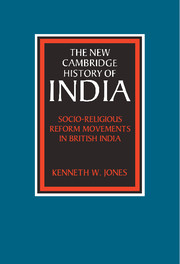Book contents
- Frontmatter
- 1 Concepts and context
- 2 Bengal and north-eastern India
- 3 The Gangetic core: Uttar Pradesh and Bihar
- 4 Punjab and the north-west
- 5 The central belt and Maharashtra
- 6 The Dravidian South
- 7 The twentieth century: socio-religious movements in a politicized world
- 8 Conclusion: religion in history
- Glossary of Indian terms
- Bibliographical essay
- Index
- THE NEW CAMBRIDGE HISTORY OF INDIA
Bibliographical essay
Published online by Cambridge University Press: 28 March 2008
- Frontmatter
- 1 Concepts and context
- 2 Bengal and north-eastern India
- 3 The Gangetic core: Uttar Pradesh and Bihar
- 4 Punjab and the north-west
- 5 The central belt and Maharashtra
- 6 The Dravidian South
- 7 The twentieth century: socio-religious movements in a politicized world
- 8 Conclusion: religion in history
- Glossary of Indian terms
- Bibliographical essay
- Index
- THE NEW CAMBRIDGE HISTORY OF INDIA
Summary
The sources used in this study were diverse and scattered through a variety of forms: monographs, articles in edited volumes, scholarly journals, unpublished manuscripts, dissertations, encyclopaedias, and government documents that included census reports, district gazetteers, and various reports. This diversity grew partly from the attempt to place socio-religious movements in their historic context, and partly from the fragmented nature of scholarly writing on religious subjects. Individuals who write about religion do so from various points of perspective, as scholars of diverse disciplines, as members of particular movements, ?.s casual observers, and ardent missionaries. Consequently, the literature varies in its sophistication, biases, factual reliability, styles of writing, and in technical issues such as the transliterations of non-English words.
Of all the literature utilized here, the one volume that proved the most comprehensive and that entailed the most similar aims to my own was J. N. Farquhar's Modern Religious Movements in India (New York, 1919). This study viewed religious movements from a sympathetic Christian perspective that judged all groups in terms of whether or not they appeared to be moving towards English Protestant Christianity, or away from it.
- Type
- Chapter
- Information
- Socio-Religious Reform Movements in British India , pp. 228 - 234Publisher: Cambridge University PressPrint publication year: 1990

